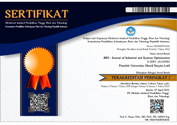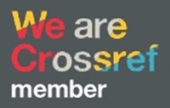PENENTUAN JUMLAH DAN PERIODE PEMESANAN BAHAN BAKU KRIMER UNTUK MEMINIMALKAN IVENTORY DI PT. ABC MOJOKERTO
DOI:
https://doi.org/10.51804/jiso.v4i1.30-37Keywords:
Inventory planning, Economic Order Quantity (EOQ), Periodic Order Quantity (POQ)Abstract
ABSTRAK
PT. ABC merupakan perusahaan manufaktur yang memproduksi krimer yang awalnya dibuat untuk memenuhi kebutuhan anak perusahaan PT. ABC yaitu PT. MM. Seiring berjalannya waktu produk krimer dapat menembus pasar dalam negeri maupun luar negeri. Pada kondisi saat ini,perhitungan kebutuhan material bahan baku yang dibutuhkan perusahaan belum dilakukan secara maksimal. Total biaya yang dikeluarkan perusahaan untuk membeli bahan baku pada produk krimer sangat besar, sehingga nilai investasi perusahaan untuk pembelian bahan baku juga sangat besar. Oleh sebab itu, pengaplikasian atau penerapan metode EOQ dan POQ diharakan dapat membantu perusahaan untuk merencanakan kebutuhan material bahan baku. Sehingga produksi dapat berjalan lancar dengan biaya persediaan yang minimal. Berdasarkan dari hasil perhitungan EOQ dan POQ dapat diketahui jumlah kebutuhan material bahan baku yang optimal pada waktu dibutuhkan, serta total biaya yang akan dikeluarkan perusahaan. Dengan teknik tersebut, maka bisa dilihat bahwa metode yang paling optimal adalah metode POQ dengan frekuensi pemesanan 9 kali, interval waktu 5,53 minggu atau 39 hari, dengan sekali pesan 5.077.007 kg dan total biaya Rp 88.695.203,24. Sehingga perusahaan memperoleh penghematan sebesar Rp 145.060.746,76,-
ABSTRACT
PT. ABC is a manufacturing company that produces creamer which was originally made to meet the needs of a subsidiary of PT. ABC namely PT. MM. Over time, creamer products can penetrate the domestic and foreign markets. In the current condition, the calculation of the material needs of the raw materials needed by the company has not been carried out optimally. The total cost incurred by the company to purchase raw materials for creamer products is very large, so the company's investment value for purchasing raw materials is also very large. Therefore, the application or application of the EOQ and POQ methods is expected to help companies to plan their material needs for raw materials. So that production can run smoothly with minimal inventory costs. Based on the results of the EOQ and POQ calculations, it can be seen the optimal amount of raw material needs at the time needed, as well as the total costs that will be incurred by the company. With this technique, it can be seen that the most optimal method is the POQ method with an order frequency of 9 times, a time interval of 5.53 weeks or 39 days, with a single order of 5,077,007 kg and a total cost of Rp. 88,695,203.24. So that the company obtains savings of Rp. 145,060,746,76,-
References
. S. (2016). PERENCANAAN KEBUTUHAN MATERIAL DENGAN METODE MATERIAL REQUIREMENT PLANNING. Jurnal Teknik Industri. https://doi.org/10.22219/jtiumm.vol15.no2.190-200
Alex Tarukdatu Naibaho. (2013). ANALISIS PENGENDALIAN INTERNAL PERSEDIAAN BAHAN BAKU TERHADAP EFEKTIFITAS PENGELOLAAN PERSEDIAAN BAHAN BAKU. EMBA.
Arif, M., Supriyadi, S., & Cahyadi (Universitas Serang Raya), D. (2017). Analisis Perencanaan Persediaan Batubara FX Dengan Metode Material Requirement Planning. Jurnal Manajemen Industri Dan Logistik, 1(2), 148. https://doi.org/10.30988/jmil.v1i2.25
Assauri, Softjan., 2004. (2013). Manajemen Produksi dan Operasi, Jakarta: Lembaga Penerbit Fakultas Ekonomi Universitas Indonesia. Jurnal Sistem Informasi. SISTEM INFORMASI PERENCANAAN PERSEDIAAN BARANG. https://doi.org/10.3112/SPEED.V4I4.893
Bruno, L. (2015). Penerapan Economic Order Quantity (EOQ) teh Goalpara Seduh dalam upaya efisiensi biaya persediaan di unit Industri Hilir Teh pada PT Perkebunan Nusantara VIII. Heizer Dan Render (2015 : 558). https://doi.org/10.1017/CBO9781107415324.004
Chuong, S. &. (2014). Penerapan Metode Economic Order Quantity Pada Bahan Baku Di Kafe Zarazara Yogyakarta. Penerapan Metode Economic Order Quantity Pada Bahan Baku Di Kafe Zarazara Yogyakarta, 1–26.
Fithri, P., & Sindikia, A. (2016). Pengendalian Persediaan Pozzolan di PT Semen Padang. Jurnal Optimasi Sistem Industri. https://doi.org/10.25077/josi.v13.n2.p665-686.2014
Khairani. (2013). Material Requirement Planning ( Mrp ) Pendahuluan.
Kusumawati, A., & Setiawan, A. D. (2017). Analisis Pengendalian Persediaan Bahan Baku Tempe Menggunakan Material Requirement Planning. Industrial Servicess.
Mbota, H. K. W., Tantrika, C. F. M., & Eunike, A. (2015). Perencanaan Persediaan Bahan Baku dan Bahan Bakar Dengan Dynamic Lot Sizing (Studi Kasus: PT Holcim Indonesia Tbk, Tuban Plant). Jurnal Rekayasa Dan Manajemen Sistem Industri.
Moch.anshori, F. (2019). PERENCANAAN PERSEDIAAN BAHAN BAKU UNTUK PRODUK SEMEN INSTAN. 2, 18–22.
Muckstadt, J. A., & Sapra, A. (2010). EOQ Model. https://doi.org/10.1007/978-0-387-68948-7_2
Prima Setya Nugraha. (2008). Analisis Pengendalian Persediaan Bahan Baku Dalam Perencanaan Produksi Studi Kasus pada PT Budi Manunggal di DIY. 54.
Supriyanto, & Barus, T. Y. (2015). ANALISIS PERENCANAAN KEBUTUHAN BAHAN BAKU DENGAN MENGGUNAKAN METODE MRP (Material Requirement Planning) DAN METODE JIT (Just In Time). ANALISIS PERENCANAAN KEBUTUHAN BAHAN BAKU DENGAN MENGGUNAKAN METODE MRP (Material Requirement Planning) DAN METODE JIT (Just In Time).
Trihudiyatmanto, M. (2017). ANALISIS PENGENDALIAN PERSEDIAAN BAHAN BAKU DENGAN MENGGUNAKAN METODE ECONOMIC ORDER QUANTITY ( EOQ ) (STUDI EMPIRIS PADA CV. JAYA GEMILANG WONOSOBO). Jurnal Penelitian Dan Pengabdian Kepada Masyarakat UNSIQ. https://doi.org/10.32699/ppkm.v4i3.427
Downloads
Published
Issue
Section
License
With the receipt of the article by JISO Editorial Board and the decision to be published, the copyright regarding the article will be transferred to JISO. The copyright transfer form can be downloaded here.
JISO has the right to multiply and distribute the article and every author is not allowed to publish the same article that was published in this journal.
JISO is licensed under a Creative Commons Attribution-ShareAlike 4.0 International License.
Under the following terms:
Attribution — You must give appropriate credit, provide a link to the license, and indicate if changes were made. You may do so in any reasonable manner, but not in any way that suggests the licensor endorses you or your use.
ShareAlike — If you remix, transform, or build upon the material, you must distribute your contributions under the same license as the original.














